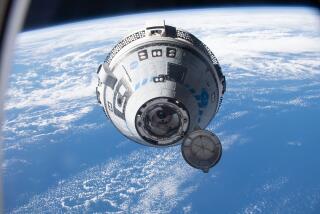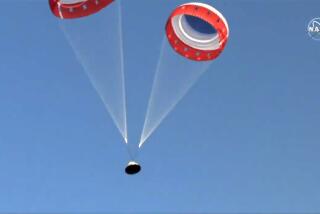Experts Hit Pressure for New Shuttle : Rocket Designers Say Schedules May Jeopardize Safety
BRIGHAM CITY, Utah — Morton Thiokol rocket engineers, under pressure from NASA to redesign the shuttle booster rockets in time for a projected July, 1987, launching, are complaining that the deadline may be creating an atmosphere in which “concern for safety is again being tempered by schedule demands.”
“The schedule seems to be driving us into early commitments to make decisions. They are trying to turn around quickly just so they’ll be able to show everyone that they could turn around quickly,” said one engineer, who, like his colleagues, agreed to be interviewed by The Times only on the condition that his name would not be used.
“We’re going too fast,” he said. “We don’t even have time to evaluate test data before we’re being asked to recommend something.”
First Internal Criticism
This is the first time internal criticism has surfaced regarding the pace of redesign efforts. But similar concern was expressed earlier this month by members of the presidential commission investigating the Jan. 28 shuttle disaster.
After witnesses from the National Aeronautics and Space Administration had testified privately on May 2 about their redesign plans, commission members reportedly were surprised at the speed of the process and “uneasy” that NASA was focusing on “little fixes.” Pressed by the commission, NASA a few days later agreed to create an independent panel to oversee the redesign.
That panel has not yet been named by the National Academy of Engineering, but until two days ago engineers at Thiokol were working to meet a deadline to present the company’s “final redesign selection recommendation” to a NASA team on May 28. The Thiokol engineers were informed on Friday that the formal presentation has been postponed.
‘Not Getting the Time’
“Management is worried about deadlines. It’s real disappointing, because we’re not getting the time we’d hoped for,” one engineer said.
Thiokol and NASA management came under fire from the commission after company engineers testified that their recommendation to postpone the Challenger launching was overruled by Thiokol vice presidents under pressure from NASA. Since then, Thiokol engineers at all levels have been told not to speak to the press. They will not speak for attribution out of fear of reprisals.
Against the backdrop of concern over the redesign process, the field of potential modifications on the rocket booster joint continues to narrow. And, although engineers say they are not ready to make a final recommendation, there are some leading candidates.
None of the top contenders would require wholesale alterations of the basic solid rocket booster--a set of four 12-foot diameter, solid fuel segments connected by joints. It was one of those joints, inadequately sealed by a pair of rubbery O-rings, that failed in the freezing morning of Jan. 28 and allowed 5,500-degree Fahrenheit gases to blow out the side of the rocket booster when it was ignited, dooming the Challenger.
Thiokol sources said that they expect at least two or three different modifications to be adopted in combination.
“That baby’s going to be dressed up in belts, suspenders and overalls--you name it. It’s going to be the safest piece of hardware on that bird,” an engineer said.
But some of the engineers contend that the pressure to produce a design quickly risks wasting time and money, and increases the possibility that a design will be submitted that cannot pass the tests.
New Concepts Promising
Furthermore, the engineers continue to assess promising new concepts that require analysis and documentation before their value can be determined.
Although the projected launching date is still more than a year away, it cannot be met unless the faulty rocket seals are improved soon enough for the testing and certification process to be concluded and the way cleared for the new designs to be incorporated into manufacture of the rocket segments.
That does not leave much slack in the schedule, the engineers noted.
NASA officials have insisted that the July, 1987, launching date is simply a target. Shuttle program chief Richard H. Truly said that the timing of any launching will be controlled by successful completion of an exhaustive testing program.
Also, some Thiokol sources dismiss as exaggerated the concern over scheduling pressures.
“We’re going to have a safe design,” one Thiokol source said. “We have a contractual obligation to solve this problem; (NASA’s) Marshall Space Flight Center has an obligation to see that we do it right; then this outside panel’s going to have to bless it--everyone in the whole world is going to have to bless this goddamned solution.
“But at some point we’re going to have to do it--quit considering options and just get on with it. That’s what a deadline is for,” the source said.
Almost certain to be among the options adopted, according to the engineers, is what they call a “capture feature.” The design already is used on some of the new, lighter filament-wound booster rockets that were to be phased in to replace heavy steel-cased rockets.
Where the rocket segments meet today, they are joined by a clevis (a U-shaped joint) mating with a tongue-like tang. The tiny gap between the metal sides is sealed with two O-rings. When the 1.2-million-pound thrust rocket is ignited during the launching, the enormous internal pressure causes the steel casings to bulge, forcing the joints to shift or “rotate.” It is during the initial milliseconds of ignition pressure that the O-rings must slam into the gaps to prevent hot gases from escaping.
The capture feature would reduce--but not eliminate--the gaps caused by rotation.
“That’s why we can’t stop with one solution. We’re going to have to have a helluva lot of them,” a Thiokol source said.
Among the Thiokol engineers, some advocate permanent pressurization of the seals before ignition to reduce rotation. And there is additional support for heating the joints.
Because the Challenger’s O-rings apparently lost resiliency in subfreezing temperatures before liftoff, a method to keep the seals heated at slightly higher temperatures than existed in the assembly building at Kennedy Space Center, Fla., would eliminate any potential temperature affects.
The system would work like an electric blanket--in this case, an “electric strap.” It would be plugged into the launching pad gantry until a few minutes before ignition and insulate the joint.
Another design that would reduce the effects of joint movement or rotation during ignition is what the engineers call the “over wrap solution.” It would beef up the mass of the rocket casing on either side of the joint, using either additional steel or filament winding.
Tests are also being conducted using spring-loaded C-rings and E-rings. These seals would capture the pressure from ignition and use it to wedge the rings more solidly into place.
Estimates are that some of the modifications would add between 200 and 300 pounds of weight to each booster rocket.





